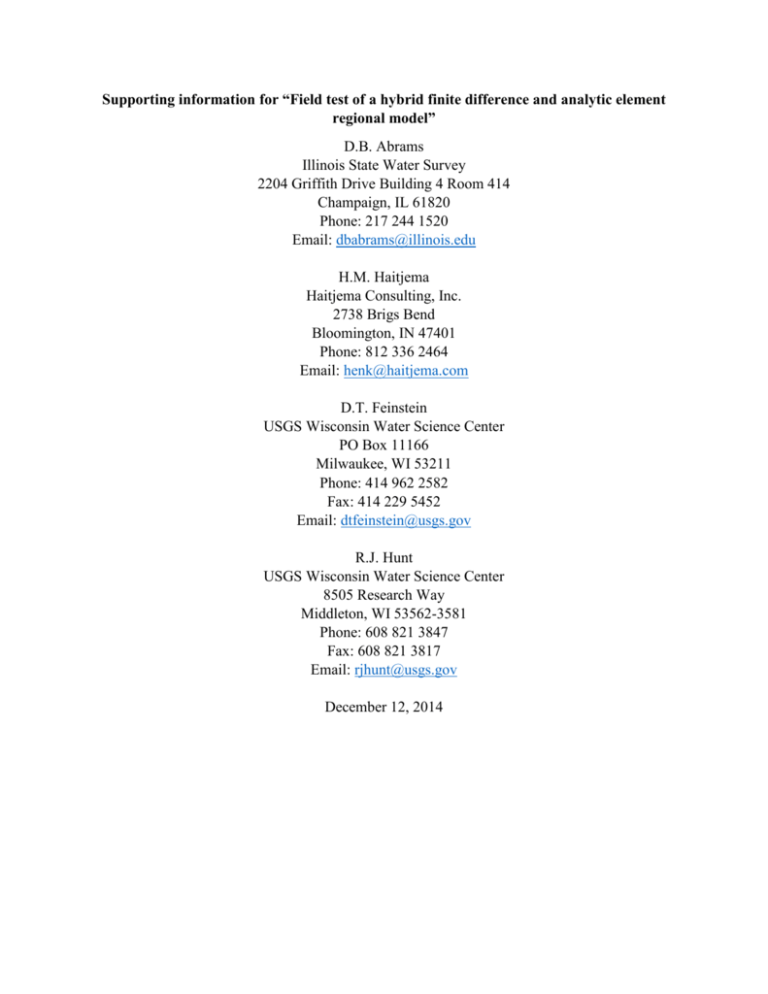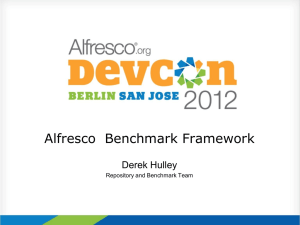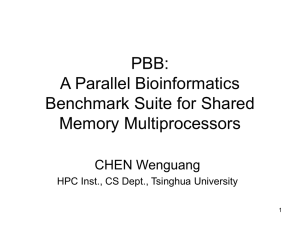gwat12319-sup-0001
advertisement

Supporting information for “Field test of a hybrid finite difference and analytic element regional model” D.B. Abrams Illinois State Water Survey 2204 Griffith Drive Building 4 Room 414 Champaign, IL 61820 Phone: 217 244 1520 Email: dbabrams@illinois.edu H.M. Haitjema Haitjema Consulting, Inc. 2738 Brigs Bend Bloomington, IN 47401 Phone: 812 336 2464 Email: henk@haitjema.com D.T. Feinstein USGS Wisconsin Water Science Center PO Box 11166 Milwaukee, WI 53211 Phone: 414 962 2582 Fax: 414 229 5452 Email: dtfeinstein@usgs.gov R.J. Hunt USGS Wisconsin Water Science Center 8505 Research Way Middleton, WI 53562-3581 Phone: 608 821 3847 Fax: 608 821 3817 Email: rjhunt@usgs.gov December 12, 2014 Appendix S1: Hydraulic conductivity in the benchmark and hybrid models In the primary manuscript, we assigned the same hydraulic conductivity and layer elevations to all cells within the benchmark model that were contained within an original model cell (see Figure 1e), referred to in this supplemental material as the checkered benchmark model. A benchmark model whereby hydraulic conductivity and layer elevations were interpolated between nodes of the original coarse model was also considered (Figure S1), referred to as the smoothed benchmark model. For purposes of testing the hybrid model performance, we sought to use the benchmark model that was most consistent with the original MODFLOW model. It is not immediately obvious whether this is the checkered or smoothed benchmark model! It appears, however, that the selection of the benchmark model should include consideration of the interblock averaging used by the original MODFLOW model. Though multiple averaging techniques are available, we will focus on two. First, “harmonic averaging” is most consistent with uniform transmissivity in each cell with discrete jumps at cell boundaries (Goode and Appel 1992), which we hypothesize is conceptually similar to the checkered benchmark model. Harmonic averaging was used in the Great Lakes Basin Model used to obtain the original MODFLOW model in the primary manuscript. Second, “logarithmic averaging” is most consistent with continuous variations of transmissivity between cell nodes (Goode and Appel 1992), which we hypothesize is conceptually similar to the smoothed benchmark model. To test our hypotheses, we compare the differences in baseflow between two original model realizations (using harmonic and logarithmic averaging) and the two benchmark realizations (checkered and smoothed). The two original models yield baseflows which differ from each other (compare red with blue in Figure S2). The gages are shown in Figure 2 of the manuscript. The two benchmark models also differ (compare purple with green). The difference between the two benchmark models and their respective original models is in the same direction (positive or negative) for all cases except A2-A1, E2-E1, and D2. So indeed, it appears that the checkered benchmark model is conceptually consistent with the original model using harmonic averaging. Similar to the benchmark model, there is no single way to assign hydraulic conductivity to the hybrid model. We tested two realizations, the 14 inhomogeneity zoned hybrid model that is the focus of the manuscript and an alternative 118 inhomogeneity checkered hybrid model. The zoned and checkered hybrid models are similar to both the smoothed and checkered baseline models in all cases, but they are closer to the checkered baseline realization (green bar in Figure S2) for all but two gages, D1 and E2-E1. This is because the checkered baseline model has the same conceptual model of discrete transitions in hydraulic conductivity as the two hybrid realizations. References: Goode, D.J and Appel, C.A., (1992). Finite-difference interblock transmissivity USGS WaterResources Investigations Report: 92-4124, 79 p. Technical report, United States Geological Survey. Figure S1: Layer 1 of the benchmark MODFLOW model with smoothed (interpolated) transmissivity. Figure S2: Baseflows in cubic meters per day (m3/day) modeled by the original, benchmark, and hybrid models assuming a smooth (logarithmic) and checkered (harmonic) transmissivity distribution. Gage locations are shown in Figure 2 of the manuscript. Where two gages are listed (e.g. A2-A1), the baseflow reported is the difference between baseflow at these two gages.








